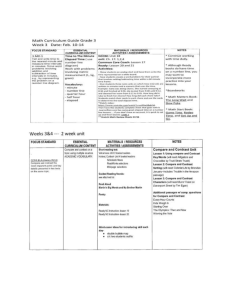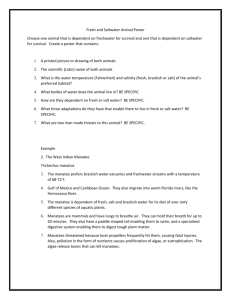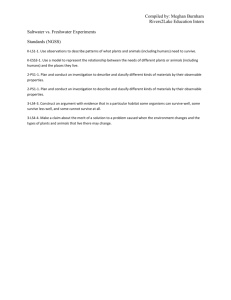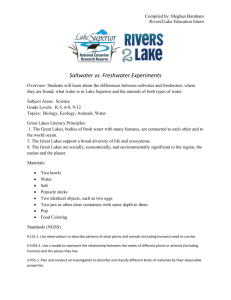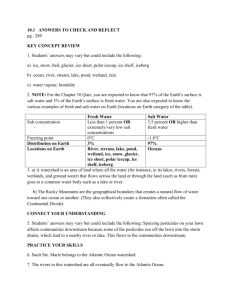environmental science freshwater vs. saltwater and
advertisement
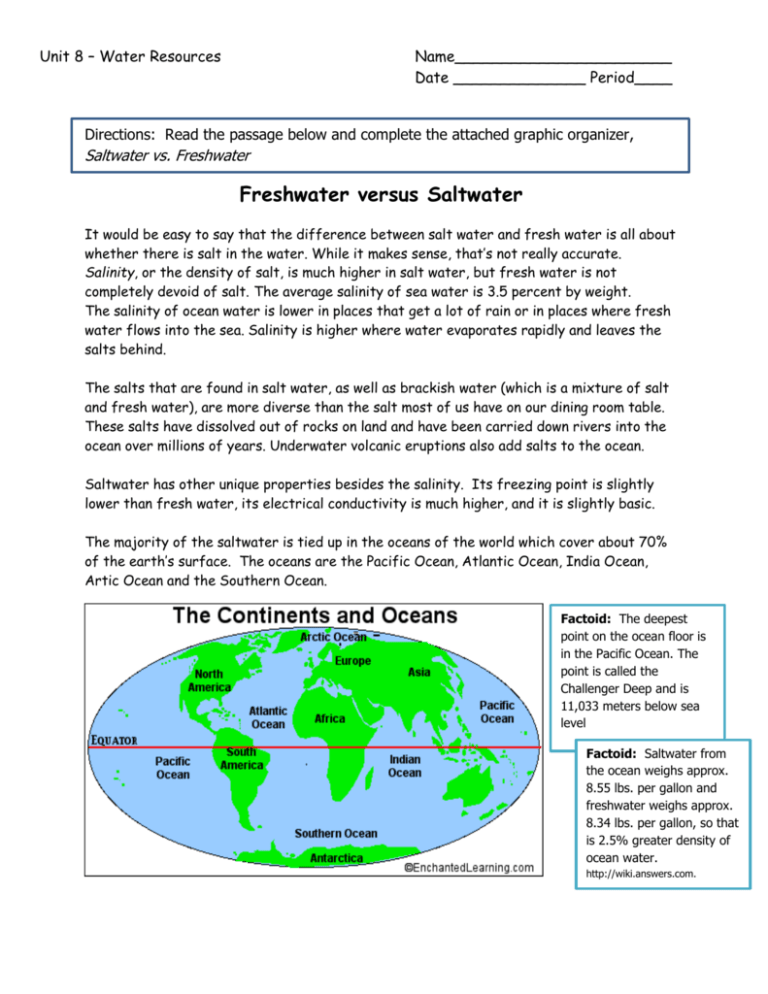
Unit 8 – Water Resources Name_______________________ Date ______________ Period____ Directions: Read the passage below and complete the attached graphic organizer, Saltwater vs. Freshwater Freshwater versus Saltwater It would be easy to say that the difference between salt water and fresh water is all about whether there is salt in the water. While it makes sense, that’s not really accurate. Salinity, or the density of salt, is much higher in salt water, but fresh water is not completely devoid of salt. The average salinity of sea water is 3.5 percent by weight. The salinity of ocean water is lower in places that get a lot of rain or in places where fresh water flows into the sea. Salinity is higher where water evaporates rapidly and leaves the salts behind. The salts that are found in salt water, as well as brackish water (which is a mixture of salt and fresh water), are more diverse than the salt most of us have on our dining room table. These salts have dissolved out of rocks on land and have been carried down rivers into the ocean over millions of years. Underwater volcanic eruptions also add salts to the ocean. Saltwater has other unique properties besides the salinity. Its freezing point is slightly lower than fresh water, its electrical conductivity is much higher, and it is slightly basic. The majority of the saltwater is tied up in the oceans of the world which cover about 70% of the earth’s surface. The oceans are the Pacific Ocean, Atlantic Ocean, India Ocean, Artic Ocean and the Southern Ocean. Factoid: The deepest point on the ocean floor is in the Pacific Ocean. The point is called the Challenger Deep and is 11,033 meters below sea level Factoid: Saltwater from the ocean weighs approx. 8.55 lbs. per gallon and freshwater weighs approx. 8.34 lbs. per gallon, so that is 2.5% greater density of ocean water. http://wiki.answers.com. Unit 8 – Water Resources Name_______________________ Date ______________ Period____ True fresh water bodies are much rarer than salt water bodies. Most of the water in the world contains high enough levels of salt to prevent it from being classified as fresh water. A little more than 2 percent of all the water on Earth is locked up in icecaps and glaciers that are so large they are hard to imagine. For instance, the ice sheet that covers Antarctica is as large as the United States and is up to 3 km thick. The rest of Earth’s fresh water is found in lakes, rivers, wetlands, the soil, rock layers below the surface, and in the atmosphere. Local freshwater examples include Nolin Lake, Freeman Lake, Mill Creek, Rolling Fork, Billy Creek and Sander Springs. Fresh water lacks the buoyancy of salt water. If you swim in a freshwater lake, you’ll find that you will have to work harder to float on the water’s surface than you would have to if you tried to float in the ocean. The Dead Sea has such a high salt level that many find it difficult to wade out past their hips, because they start to float! The ecological differences are interesting. Fish, amphibians, and plants generally cannot live in both types of water. Their natural development lends them to their preferred salt content level. Taking a fresh water fish and putting him in a salt water tank is about as effective as leaving him on the beach! He won’t be able to survive. There are alligators, however, that have adapted to fresh and salt water environments. Adapted from http://www.differencebetween.net/science/nature/difference-between-salt-water-andfresh-water/#ixzz2MmCMUqdF http://www.nexuslearning.net/books/Holt_Env_Science/3-3.pdf http://www.city-data.com/county/Hardin_County-KY.html#ixzz2MnpaLXDg Unit 8 – Water Resources Name_______________________ Date ______________ Period____ Directions: Read the passage below and complete the attached graphic organizer, Surface water vs. Ground Water Surface Water versus Ground Water The water found on the surface of the earth, like water in the river or lake, is known as surface water. The water that is trapped under the earth’s surface is the ground water. Ground water is formed as rain and melting snow sink into the ground and run off the land. Some of this water ends up in streams and rivers, but most of it trickles down through the ground and collects as groundwater. But ground-water accounts for less than 1 percent of all the water on Earth. A rock layer that stores and allows the flow of ground-water is called an aquifer. The surface of the land where water enters an aquifer is called a recharge zone. Ground water is normally used in households for drinking, cooking and other activities. The surface water may also be used for drinking and washing, but they have many other uses, like in agriculture and generating electricity. http://water.ky.gov/groundwater/Pages/GroundwaterAwareness.aspx The surface water also recharges the underground water. The rainwater that drips deep into the ground, melting snow and glaciers recharge the ground water. It can be seen that surface water is exposed to evaporation whereas ground water is not. Another difference that can be seen between surface water and ground water is in the temperature. The ground water maintains a constant temperature whereas the temperature of surface water alters according to the surroundings. There is also much difference in the chemical composition between surface water and ground water. For example, the surface water contains less salt content when compared to ground water. Moreover, as the depth increases, the salt content also increases. Unlike the surface water, ground water is free from pathogenic organisms such as salmonella and malaria. In mineral content, ground water contains more minerals than surface water. Surface water contains different contaminants like pesticides, animal wastes, insecticides, algae, industrial wastes and other organic materials. Though some think that ground water contains less contaminants, it is not true. All the contaminants present in the surface water are also seen in ground water. Adapted from http://www.differencebetween.net/miscellaneous/difference-between-surface-water-and-groundwater/#ixzz2Mm8dijTp and http://www.nexuslearning.net/books/Holt_Env_Science/3-3.pdf Unit 8 – Water Resources Name_______________________ Date ______________ Period____ Freshwater vs. Saltwater Graphic Organizer 1. Distinguish between freshwater and saltwater by listing differences below from the article. Freshwater Saltwater Unit 8 – Water Resources Name_______________________ Date ______________ Period____ Surface Water vs. Ground Water Graphic Organizer 2. Distinguish between surface water and ground water by listing differences below from the article. Surface Water Ground Water Unit 8 – Water Resources Name_______________________ Date ______________ Period____ Freshwater vs. Saltwater Practice Sheet On a separate sheet of paper, give complete answers to the following questions and be ready to discuss tomorrow. 1. Distinguish between freshwater and saltwater by elaborating upon 3 different characteristics. 3. Distinguish between surface and groundwater by comparing 3 facts about each. 4. Discuss 3 environmental issues related to surface water and/or ground water. Explain why these are issues and what may be done to resolve these issues. 5. Explain 5 ways in which people can conserve water.
